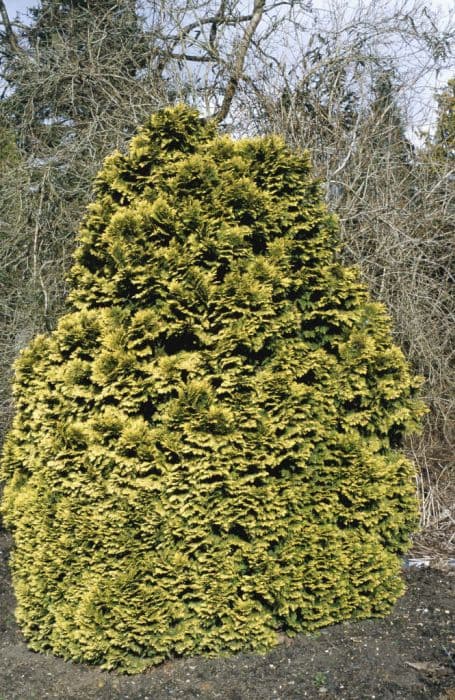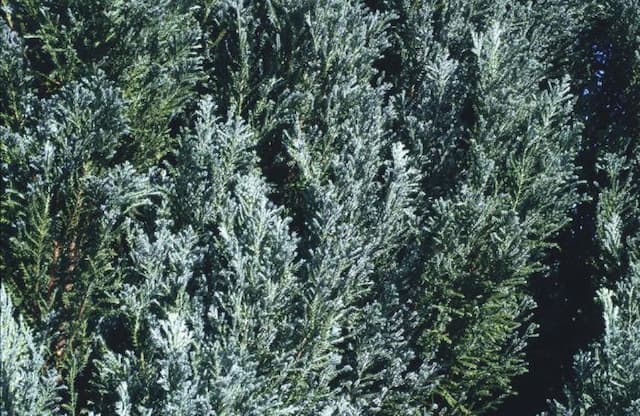Dwarf Gold Lawson Cypress Chamaecyparis lawsoniana 'Minima Aurea'











ABOUT
The plant known as the Golden Lawson Cypress 'Minima Aurea' is a decorative and eye-catching conifer with distinctive foliage that has a soft, feathery texture. The leaves of the Golden Lawson Cypress are arranged in flattened sprays and present a vibrant yellow hue which can add a bright, cheerful splash of color to any garden space. This golden coloration is most pronounced in the new growth, particularly in full sunlight, where the tips of the branches light up with golden hues, lending the plant a radiant appearance. As the seasons change, the plant's golden foliage can take on different hues, adding seasonal interest to its visual appeal. The overall form of the Golden Lawson Cypress 'Minima Aurea' is conical, with a naturally elegant and compact growth habit that contributes to its ornamental value. It is often chosen for its textural qualities and its ability to bring color to landscapes without overshadowing other plants, fitting well into a variety of garden designs and settings.
About this plant
 Names
NamesFamily
Cupressaceae
Synonyms
Dwarf Golden Lawson Cypress, Miniature Golden Lawson False Cypress, Minima Aurea Lawson Cypress
Common names
Chamaecyparis lawsoniana 'Minima Aurea'.
 Toxicity
ToxicityTo humans
The common name of Chamaecyparis lawsoniana 'Minima Aurea' is Lawson's Cypress. This particular plant is generally not considered highly toxic to humans. However, ingesting parts of the plant can potentially cause mild stomach upset as a non-specific reaction to consuming plant material. There isn't a well-documented profile of specific toxicities or a detailed list of symptoms associated with this plant for humans because it's not commonly ingested, and significant poisoning is rare.
To pets
For Lawson's Cypress, there isn't significant information available on its toxicity to pets like cats and dogs. It's not listed as a commonly toxic plant to these animals. However, just like with humans, if pets were to ingest a large amount of this plant, they might experience some gastrointestinal discomfort, such as vomiting or diarrhea. It's generally recommended to prevent pets from ingesting plants, both because they could have individual sensitivities and because even non-toxic plants can cause upset due to the fiber content or other non-toxic compounds.
 Characteristics
CharacteristicsLife cycle
Perennials
Foliage type
Evergreen
Color of leaves
Green
Height
3 feet [0.91 meters]
Spread
2 feet [0.61 meters]
Plant type
Shrub
Hardiness zones
5
Native area
Northwest America
Benefits
 General Benefits
General Benefits- Ornamental Appeal: The Chamaecyparis lawsoniana 'Minima Aurea', commonly known as Golden Lawson Cypress, adds aesthetic value with its bright golden-yellow foliage.
- Compact Growth: Being a dwarf cultivar, it fits well in small gardens or landscapes with limited space.
- Low Maintenance: It requires minimal pruning and care compared to larger trees, making it ideal for busy gardeners.
- Evergreen Nature: As an evergreen, it provides year-round color and structure to a garden.
- Drought Tolerance: The Golden Lawson Cypress can withstand periods of dry weather once established, reducing the need for frequent watering.
- Wildlife Habitat: It offers shelter and nesting sites for various species of birds and insects.
- Privacy Screen: Its dense foliage can serve as a natural privacy barrier in residential areas.
- Soil Stability: The plant's root system can help in preventing soil erosion in certain landscapes.
- Climate Adaptability: It can thrive in a variety of climates, making it a versatile choice for many locations.
 Medical Properties
Medical PropertiesThis plant is not used for medical purposes.
 Air-purifying Qualities
Air-purifying QualitiesThis plant is not specifically known for air purifying qualities.
 Other Uses
Other Uses- Miniature Bonsai: Due to its small size and slow growth, Port Orford cedar 'Minima Aurea' can be trained as a bonsai specimen for enthusiasts of this ancient art form.
- Model Making: The fine-grained wood of the plant, when mature, is suitable for crafting detailed models or for miniature woodworking projects.
- Photographic Subjects: The golden hues of 'Minima Aurea' offer photographers a unique subject to capture, especially in the changing light of morning or evening.
- Garden Sculpture Surrogate: This plant's natural, compact shape can mimic the look of a sculpted piece, adding structural interest without the need for an actual statue.
- Mood Enhancer: The bright colors of the foliage can help lift spirits in a garden setting, providing a cheerful spot during dreary weather.
- Natural Playhouses: When planted in groups, they can create small "rooms" or natural playhouses for children, encouraging outdoor play and imagination.
- Wedding Decor: Because of its aesthetic appeal, branches from the Port Orford cedar 'Minima Aurea' can be used in floral arrangements or as part of venue décor for a natural-themed wedding.
- Educational Tool: This variety can be used by schools or educational programs to teach about plant growth, conifers, or dwarf plant varieties in a hands-on manner.
- Landscape Themes: It can contribute to a larger garden theme, such as a 'gold' garden, where all plants feature golden foliage as their unifying trait.
- Privacy Screens: For small spaces, multiple specimens can be planted in a row to create a low, dense privacy screen that requires minimal space and maintenance.
Interesting Facts
 Feng Shui
Feng ShuiThe Lawson's Cypress is not used in Feng Shui practice.
 Zodiac Sign Compitability
Zodiac Sign CompitabilityThe Lawson's Cypress is not used in astrology practice.
 Plant Symbolism
Plant Symbolism- Longevity: Chamaecyparis lawsoniana 'Minima Aurea', commonly known as Lawson's Cypress, is a coniferous plant that can live for many years. Its longevity symbolizes endurance and the ability to withstand the test of time.
- Peace: Conifers like the Lawson's Cypress are often found in tranquil, serene settings, making them a symbol of peace and solace.
- Sanctuary: With its dense foliage, Lawson's Cypress can provide a protective cover for wildlife, symbolizing sanctuary and safety.
- Healing: Historically, the wood and sap of conifers have been used for medicinal purposes, and thus this plant can represent healing and medicinal properties.
- Resilience: The Lawson's Cypress is known for its hardiness and ability to grow in various climates, symbolizing resilience and adaptability.
 Water
WaterThe Golden hinoki cypress (Chamaecyparis lawsoniana 'Minima Aurea') should be watered thoroughly, allowing the soil to be moist but not saturated. During the growing season, typically spring through fall, the plant should be watered once a week, depending on local weather conditions and soil drainage. During the winter, reduce watering frequency to every two to three weeks. Always check the soil moisture level before watering; it should be slightly dry an inch below the surface. When watering, apply water at the base of the plant until it starts to run out of the drainage holes, which might be around 1 to 2 gallons for a medium-sized plant in a garden setting.
 Light
LightThe Golden hinoki cypress thrives best in full sun to partial shade conditions. It should be planted in a spot where it can receive at least 4 to 6 hours of direct sunlight daily. However, in extremely hot climates, providing some afternoon shade will help protect the foliage from potential scorching.
 Temperature
TemperatureThe ideal temperature range for Golden hinoki cypress is between 60°F and 70°F during its active growth period. This plant can withstand temperatures as low as -20°F in winter and as high as 90°F in summer, making it quite hardy. However, it's best to avoid sudden extreme temperature changes which could stress the plant.
 Pruning
PruningPruning the Golden hinoki cypress is generally done to maintain its desired shape and size or to remove dead and diseased branches. Light pruning should be conducted in late winter or early spring before new growth begins. This promotes healthy growth and reduces the risk of disease. It's best to avoid heavy pruning as the plant may not recover well from severe cuts.
 Cleaning
CleaningAs needed
 Soil
SoilThe Golden Dwarf Hinoki Cypress thrives best in well-draining, moist soil with a mixture of peat, coarse sand, and pine bark. Aim for a soil pH between 5.0 and 6.0 to ensure optimal growth conditions.
 Repotting
RepottingThe Golden Dwarf Hinoki Cypress should be repotted every 2 to 3 years to prevent the root system from becoming pot-bound and to replenish the soil's nutrients.
 Humidity & Misting
Humidity & MistingThe Golden Dwarf Hinoki Cypress prefers moderate to high humidity levels, ideally between 40% and 70%, to mimic its natural habitat and support its foliage's health.
 Suitable locations
Suitable locationsIndoor
Provide bright, indirect light and ensure adequate humidity.
Outdoor
Plant in well-draining soil; partial shade to full sun.
Hardiness zone
5-8 USDA
 Life cycle
Life cycleThe life cycle of Chamaecyparis lawsoniana 'Minima Aurea', commonly known as the Lawson cypress 'Minima Aurea', begins with seed germination, where the seeds require well-drained and moist conditions to sprout. Once germinated, the seedling undergoes a period of slow growth, developing into a juvenile plant with a distinct golden to yellowish foliage due to its dwarf nature. As it matures, the Lawson cypress 'Minima Aurea' forms a dense, conical shape, reaching its mature size of approximately 3-4 feet tall and 2-3 feet wide over many years. During its reproductive phase, which may take several years to commence, it produces small, inconspicuous male and female cones on the same plant, with pollination occurring typically by the wind. After successful fertilization, the female cones mature and release seeds to complete the cycle. The lifespan of this evergreen conifer can be several decades, given appropriate conditions and minimal disturbance.
 Propogation
PropogationPropogation time
Spring-Early Summer
The most common common name for Chamaecyparis lawsoniana 'Minima Aurea' is the Golden Dwarf Lawson Cypress. It is typically propagated through semi-hardwood cuttings. The best time to take these cuttings is during the summer months when the wood has matured but is not yet fully hard, often from July to September. To propagate, cut a piece of semi-hardwood about 4 to 6 inches (10 to 15 centimeters) long with several leaf nodes. Remove the leaves from the lower half of the cutting and dip the cut end into rooting hormone to encourage root development. The cutting should then be inserted into a well-draining soil mix and kept consistently moist but not waterlogged. It's essential to provide high humidity by covering the pot with a plastic bag or using a propagation dome until roots have formed, which usually takes several weeks to a few months.









